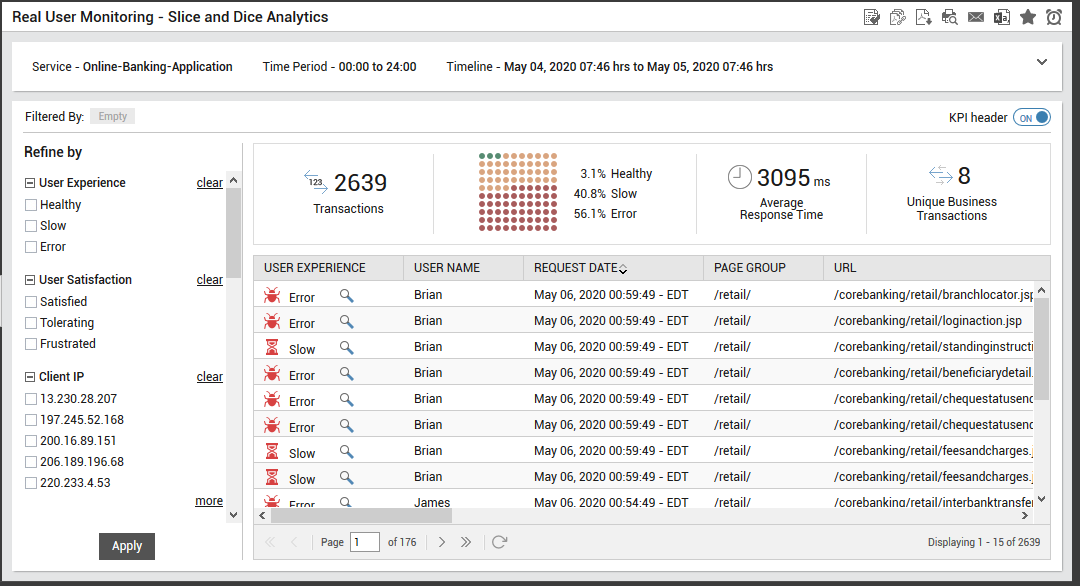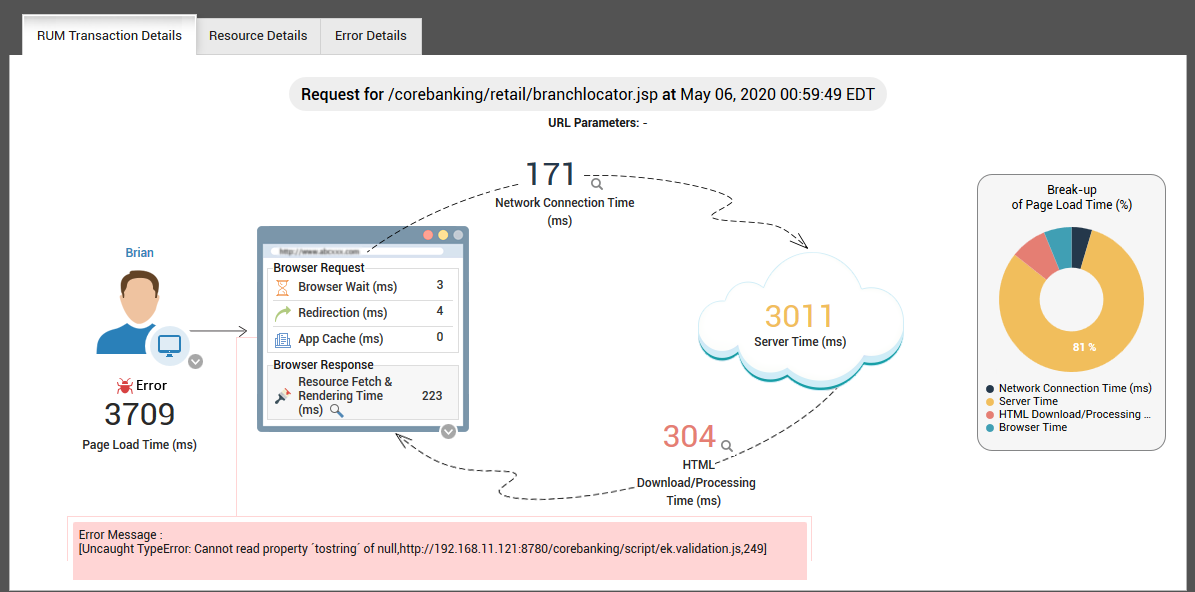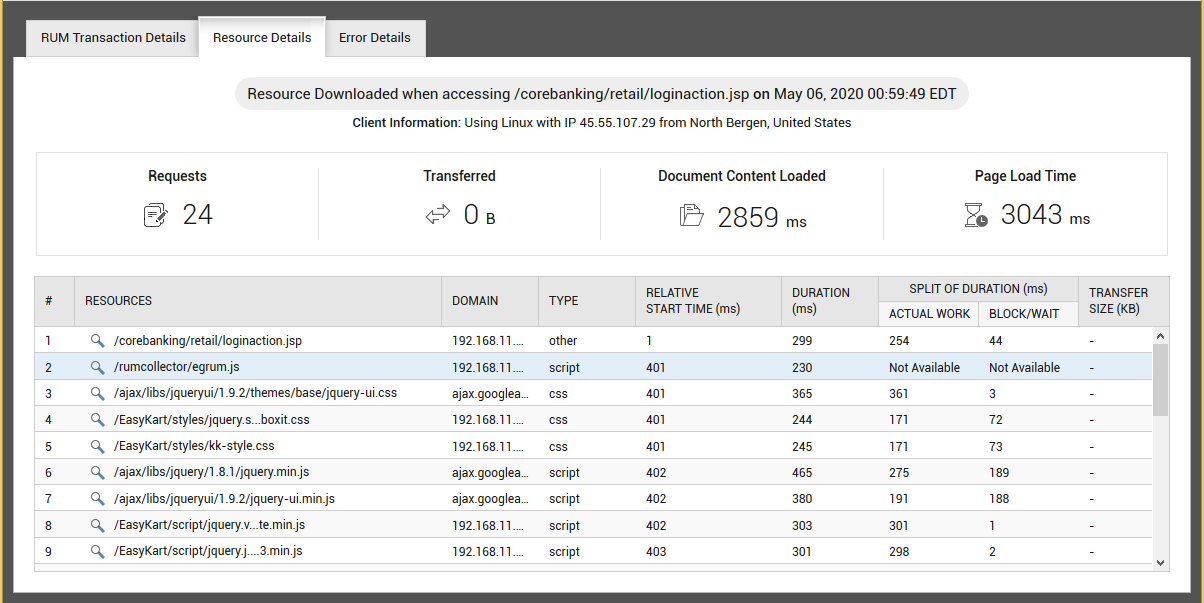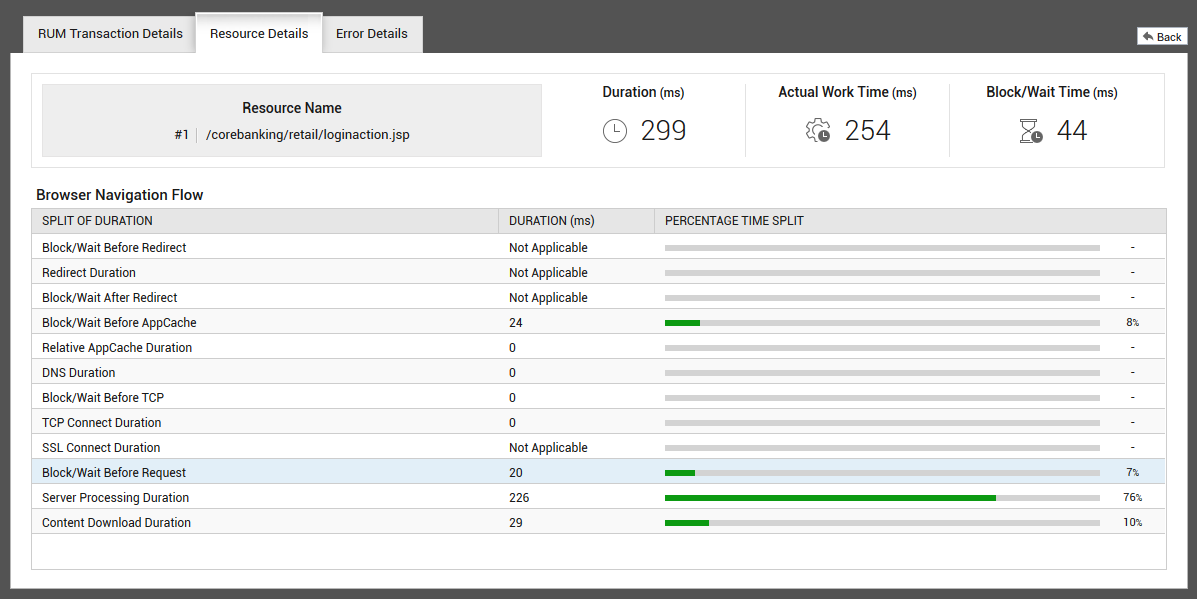Real User Monitoring - Slice and Dice Analytics Report
By default, the Slice and Dice Analytics report provides administrators with an overview of the user experience with a web application, for a given period of time in the past. Besides displaying the total number of transactions that were performed on the chosen web application during the given period, the report also reveals the percentage of transactions that were healthy, slow, and error-prone, thus clearly indicating to administrators if overall user experience with the web application was satisfactory or not. Additionally, the report also allows administrators to easily pick and choose what perspectives to user experience they want to view and analyze in the report. For instance, administrators can choose to focus on slow pages alone, or historically analyze how specific page groups / URLs have performed over time. Likewise, they may need insights on page view requests coming from specific client IP addresses. This report supports such granular/focused analysis as well, so that administrators can view only what they want to in the report, exclude statistics that may distract them, isolate bottlenecks to user experience quickly and precisely, and troubleshoot efficiently.
To generate this report, do the following:
- Login to eG Reporter.
- Follow the menu sequence: REPORTS BY FUNCTION -> Domain-specific Reports -> Web Application Monitoring -> Real User Monitoring -> Slice and Dice Analytics.
-
Figure 1 then appears. In Figure 1, select a criterion for analysis from the Analyze By list box.

-
Using this report, you can engage in a time-based user experience analysis on a web application that is part of a zone/segment/service. Indicate your choice by picking the one of the following options from the Analyze by list.
- Component:If the Component option is chosen from the Analyze by list, then all components of the chosen Component Type will be listed in the Component list box. From this list box, select the components for which the report is to be generated. If the Component list consists of too many components, then viewing all the components and selecting the ones you need for report generation could require endless scrolling. To avoid this, you can click the
 button next to the Component list. The COMPONENTS pop up window will then appear using which you can view almost all the components in a single interface and select the ones for which the report is to be generated.
button next to the Component list. The COMPONENTS pop up window will then appear using which you can view almost all the components in a single interface and select the ones for which the report is to be generated. - Zone: If the Zone option is chosen from the Analysis by list, then you would be required to select the Zone for which the report is to be generated. In addition, you will also have to indicate whether the report needs to include even those components that are included in the sub-zones of the chosen zone. If this is the case, you will have to set the Include sub-zones flag to Yes.
- Service: Select this option if the components for which a report is to be generated are involved in the delivery of a business service. Then, select a Service.
- Segment: Choose this option if the virtual hosts to be evaluated are part of a segment. Then, pick a Segment for analysis.
- Component:If the Component option is chosen from the Analyze by list, then all components of the chosen Component Type will be listed in the Component list box. From this list box, select the components for which the report is to be generated. If the Component list consists of too many components, then viewing all the components and selecting the ones you need for report generation could require endless scrolling. To avoid this, you can click the
- Next, select the Component Type for which the report is to be generated.
-
The Components list will then be populated with the components that belong to the chosen Component Type. Select a component of your choice from this list. If the Components list consists of too many components, then viewing all the components and selecting the ones you need for report generation could require endless scrolling. To avoid this, you can click the
 button next to the Components list. A COMPONENTS pop up window will then appear using which you can view almost all the components in a single interface and Select the ones to be included in this report.
button next to the Components list. A COMPONENTS pop up window will then appear using which you can view almost all the components in a single interface and Select the ones to be included in this report. -
Provide a report Timeline. You can either select a fixed timeline such as 1 hour, 2 days, etc., or choose the Any option from the Timeline list, and then provide a From and To date/time for report generation.
Note:
For every user registered with the eG Enterprise system, the administrator can indicate the maximum timeline for which that user can generate a report. Once the maximum timeline is set for a user, then, whenever that user logs into eG Reporter and attempts to generate a report, the Timeline list box in the report page will display options according to the maximum timeline setting of that user. For instance, if a user can generate a report for a maximum period of 3 days only, then 3 days will be the highest option displayed in the Timeline list - i.e., 3 days will be the last option in the fixed Timeline list. Similarly, if the user chooses the Any option from the Timeline list and proceeds to provide a start date and end date for report generation using the From and To specifications, eG Enterprise will first check if the user's Timeline specification conforms to his/her maximum timeline setting. If not, report generation will fail. For instance, for a user who is allowed to generate reports spanning over a maximum period of 3 days only, the difference between the From and To dates should never be over 3 days. If it is, then, upon clicking the Run Report button a message box will appear, prompting the user to change the From and To specification.
-
In addition to the settings discussed above, this report comes with a set of default specifications. These settings are hidden by default. If you do not want to disturb these default settings, then you can proceed to generate the report by clicking the Run Report button soon after you pick a Measure. However, if you want to view and then alter these settings (if required), click on the
 icon. The default settings will then appear in the MORE OPTIONS drop down window (see Figure 2). The steps below discuss each of these settings and how they can be customized.
icon. The default settings will then appear in the MORE OPTIONS drop down window (see Figure 2). The steps below discuss each of these settings and how they can be customized.
Figure 2 : The default settings for generating the Slice and Dice Analytics report
-
If the timeline specified for the report needs to exclude the data collected during the Weekends, then set Exclude weekends to Yes. If not, select No.
Note:
By default, the weekend constitutes Saturday and Sunday. To override this default setting, do the following:
- Edit the eg_report.ini file in the <EG_INSTALL_DIR>\manager\config directory.
- In the [RUM_REPOTRS] section of the file, the EXCLUDE_WEEKEND parameter is set to Saturday, Sunday by default. You can modify this by setting the EXCLUDE_WEEKEND parameter to a comma-separated list of other days of the week - say Friday, Saturday.
- Save the file after making the required changes.
- Next, specify the start time and end time for report generation against the Time period field.
-
In large environments, reports generated using months of data can take a long time to complete. Administrators now have the option of generating reports on-line or in the background. When a report is scheduled for background generation, administrators can proceed with their other monitoring, diagnosis, and reporting tasks, while the eG manager is processing the report. This saves the administrator valuable time. To schedule background processing of a report, select the Background Save - PDF option from the Report Generation list. In this case, a Report Name text box will appear, where you would have to provide the name with which the report is to be saved in the background. To process reports in the foreground, select the Foreground Generation - HTML option from this list.
Note:
- The Report Generation list will appear only if the EnableBackgroundReport flag in the [BACKGROUND_PROCESS] section of the eg_report.ini file (in the [EG_INSTALL_DIR]\manager\config directory) is set to Yes.
- The default selection in the Report Generation list will change according to the Timeline specified for the report. If the Timeline set is greater than or equal to the number of days specified against the MinDurationForReport parameter in the [BACKGROUND_PROCESS] section of the eg_report.ini file, then the default selection in the Report Generation list will be Background. On the other hand, if the Timeline set for the report is lesser than the value of the MinDurationForReport parameter, then the default selection in the Report Generation list will be Foreground. This is because, the MinDurationForReport setting governs when reports are to be processed in the background. By default, this parameter is set to 2 weeks - this indicates that by default, reports with a timeline of 2 weeks and above will be processed in the background.
- Click the Done button if any changes were made to the More Options drop down window.
- Finally, click the Run Report button to generate the report.
-
If the Report type is Foreground Generation - HTML, then Figure 3 will appear as soon as you click the Run Report button.

-
Clicking on a user experience with each page view from the USER EXPERIENCE column in Figure 3 will lead you to Figure 4.

Figure 4 : The RUM Transaction Details page displaying the entire flow of the page request/transaction
- By closely analyzing the page request/transaction inFigure 4, administrators can figure out where exactly the problem lies in a chosen page request. From the transaction details in Figure 4, it is evident that the page load time was higher for the chosen page request/transaction.
-
To determine the resource utilization time spent by the user, you can click on the magnifying glass against in Figure 4. This will lead you to Figure 5.

Figure 5 : The Resource Details tab page revealing the resources that took too long to be downloaded from the server
To know where resource download was bottlenecked, click on the 'magnifying glass' icon alongside the problematic resource in Figure 5. Figure 6 will then appear.

Figure 6 : Resource fetch time break-up
For a chosen resource, Figure 6 quickly reveals where resource download was delayed - on the browser? the network? or the server? If the delay was at the browser or the network, then the granular insights provided by Figure 6 will enable web masters to accurately identify the exact browser/network activity that caused resource loading slowness - redirection? AppCaching? browser wait? TCP connection? DNS lookup? or SSL handshake?
- On the other hand, if the Background Save - PDF option is chosen from the Report Generation list, then clicking on the Run Report button will not generate the report and display it in this page for your benefit. Instead, a message indicating that the report is being processed in the background will appear. This will be accompanied by a link that will lead you to the page that lists all the reports that are being processed in the background, and their current status. If background report generation fails for a report, you can regenerate that report using this page, or can even delete that report if need be. On the other hand, if background processing successfully completes for your report, then, you can view a PDF of the report by clicking on the
 icon in that page.
icon in that page.
